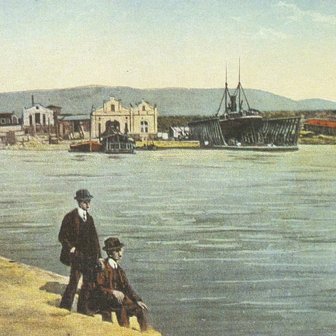ON THE INDUSTRIAL HISTORY OF GREECE
Regardless of whether we compare it with western or eastern Europe, the history of industry in Greece remains a special case. The initial conditions were unfavourable, as Greece is made up of innumerable widely scattered islands and a mainland fragmented by craggy mountain ranges. Raw materials such as coal and iron ore are lacking and its agriculture was shaped by centuries of large estate holdings, so that the impetus for development was almost non-existent.
However, trade blossomed in northern Greece under Ottoman rule: in the 18th century, central Europe imported vast quantities of grapes processed as raisins and “currants”; additionally, France’s first textile factories demanded cotton, and textile production flourished in small cities such as Naoussa and Ambelakia. The heart of this development was the port city of Thessaloniki, where Jewish and Greek merchants built profitable trade relationships over land and sea routes.
The independent state of Greece, founded in the south in 1832, faced an enormous challenge. Often divided by powerful family clans, held back by illiteracy and a lack of capital and labour, the young state did not experience its first, modest economic upturn until the 1860s. The share of agriculture in gross domestic product declined, surprisingly mainly in favour of the service sector. But industry grew as well, particularly on account of the processing of agricultural products such as foodstuffs and tobacco, as well as textile manufacturing. Ship construction for the Greek merchant marine also played a role, and remains one of the nation’s strongest industries today. The shipyards of the Aegean Island of Syros, for instance, were among the pioneers in building steel ships and steamships. The ancient silver and lead mines at Lavrion, near Athens, were reopened, though interestingly with French capital. The government expanded the rail network toward the end of the century, and opened the Corinth Canal in 1893.
The economy gained momentum in the north as well, which was still under Ottoman rule. Silk production thrived in Thrace. Thessaloniki experienced rapid population growth, and was connected by rail to Skopje in 1872 and to Belgrade soon after. Macedonia with its commercial metropolis became a part of the Greek state in 1913.
The Greek campaign in Asia Minor following the First World War ended in disaster in 1922, but triggered an economic boom. Forced to accommodate over half a million refugees, the government carried out land reform and modernised the agricultural sector. At the same time, it expanded the transportation network and the ports. The Marathon Dam was erected north of Athens. As well-trained workers were now available, the nation experienced a further industrial impetus: more technically sophisticated industries such as machine tools, chemical and textile production outstripped food and tobacco processing. Mining expanded thanks to the discovery of bauxite, the most important raw material for manufacturing aluminium. However, the industrial structure was characterised by small operations, and technical innovation played only a minor role.
After the Second World War and the subsequent civil war, recovery was slow. The transportation infrastructure was improved further using Marshall Plan aid, and a nation-wide electricity grid and telephone network were built. This period also saw the start of energy production using native lignite. As the Greek drachma remained stable over a long period, the third period of industrial growth occurred in the mid-1960s, driven by the construction industry. The economy grew almost as fast as Japan’s, and productivity improved significantly. In 1968, the share of industry in gross domestic product exceeded that of agriculture for the first time, before declining again just a few years later in 1975.
Ultimately, industry never acquired the same significance as in western nations. Instead, after the end of the 19th century the declining share of agriculture shifted to the service sector. The state, which created hundreds of thousands of administrative jobs, played a major role here. This was supplemented from the mid-20th century by the booming tourism industry. With the exception of the large shipping lines, industrial operations are much more likely to be run as small family companies than professionally managed enterprises focused on profit and innovation. Greece’s industrialisation is not yet complete, but scholars are already debating whether the country should attempt an alternative development strategy instead of desperately struggling to catch up.


